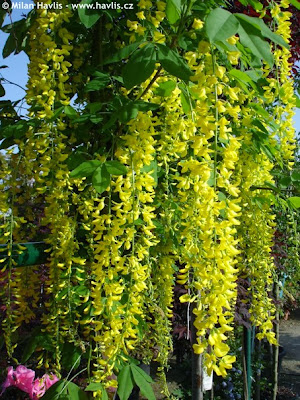Thursday, March 6, 2014
Golden Chain Tree
A genus of only 2 species of trees, both native to Europe, that are part of the larger Legume family. Laburnums are poisinous, they DO NOT contain Entheogens and in fact may be fatal poisonous if consumed...do not eat any part of this plant.
That being said...a well grown Laburnum really is a beautiful landscape tree.
They prefer full sun to partial shade on consistently moist, well drained soil. Laburnums also prefer cool summers and especially do not like hot humid nights found in the south and southeastern U.S.. They also respond well to generous potassium fertilizer. Young trees should be pruned to a single leader and feathered ( side shoots shorten and spaced ) to create a strong scaffold. Lower branches should be gradually limbed up and suckers should be removed. Wounds do not heal well so it is best to do any corrective pruning while trees are young. Some trees seed heavily drawing energy away from growth. Deadheading after flowering, is recommended if improved vigor is desired. Young trees should be staked so they dont rock to death.
Laburnums do not enjoy root disturbance so it is best of plant while young. It is also important to purchase trees that are not rootbound since potbound trees are prone to girdling.
Trees are reproduced from seed which germinates quickly if soaked for a day in warm water before sowing.
* photos of unknown internet source



Laburnum alpinum ( Scotch Laburnum )
A small broadly spreading tree native to central and southern Europe.
Some records include: fastest recorded growth rate - 3 feet; 20 years - 23 x 20 feet; largest on record - 53 x 33 feet with a trunk diameter of 4.2 feet; longest lived - 176 years.
The trifoliate leaves are composed of 3 pointed, elliptical leaflets, up to 4 x 1 inches. The foliage is smooth glossy deep green above, smooth light green beneath.
In autumn the foliage turns golden-yellow to bronze.
The pea-like bright golden-yellow flowers, up to 0.65 inches, are borne in drooping racemes, up to 18 inches in length, during early summer.
They are followed by a smooth shiny brown flattened pods, up to 3 inches in length. The seedpods contain poisonous brown seeds.
The dark gray bark is smooth on young trees, shallowly fissured on older trees.
Hardy zones
Hardy zone 3 to 7
Laburnum vulgare ( Common Laburnum )
Also called Laburnum anagyroides. A small broadly spreading tree Europe.
Some records include: fastest recorded growth rate - 4 feet; 20 years - 36 x 20 feet; largest on record - 56 x 36 feet with a trunk diameter of 5.1 feet; longest lived - 350 years.
The trifoliate leaves are composed of 3 blunt to round-tipped, oval leaflets, up to 4 x 1.5 inches. The foliage is smooth dull to glossy deep green above, smooth light green beneath.
In autumn the foliage turns golden-yellow to bronze.
The pea-like bright golden-yellow flowers, up to 1 inch, are borne in drooping racemes, up to 10 inches in length, during late spring.
They are followed by a smooth brown pod, up to 3 inches in length. The seedpods contain poisonous black seeds. The pods often persist through the winter.
The dark gray bark is smooth on young trees, shallowly fissured on older trees.
Hardy zones
Hardy zone 3 to 9. Unlike Laburnum alpinum, this one has actually been known to grow in south Florida.
* photos taken by Milan Havlis, owner of central Europes premier plant nursery


Autumnale
Blooms again in fall.
Pendulum
Slender branches are drooping in habit.
Laburnum x watereri ( Waterer Laburnum )
The hybrid between Laburnum alpinum & L. vulgare; forming a small broadly spreading tree. Some records include: fastest recorded growth rate - 3 feet; 5 years - 13 x 5 feet; 20 years - 23 x 17 feet; largest on record - 36 x 36 feet. Rare in the U.S.; it is known to grow in Washington, D.C. at the Smithsonian Arts & Industries Building.
The trifoliate leaves are composed of 3 pointed, elliptical leaflets, up to 3 x 1 inches. The foliage is smooth glossy deep green above, hairy then later turning light green beneath. In autumn the foliage turns golden-yellow to bronze.
The pea-like bright golden-yellow flowers, up to 1 inch, are borne in dense hanging racemes, up to 12 inches in length, during late spring.
They are followed by a smooth brown pod, up to 3 inches in length. The seedpods contain poisonous brown seeds.
The bark is olive and smooth on young trees, dark gray and shallowly fissured on older trees.
Hardy zones 3 to 8
* photos taken on May 18 2013 in Howard Co., MD




Vossii
Exceptional long flower racemes, up to 24 inches in length. Flowering is also more profuse. The seeds are sparse making for another plus.
* photo taken by Milan Havlis, owner of central Europes premier plant nursery

Subscribe to:
Post Comments (Atom)

No comments:
Post a Comment